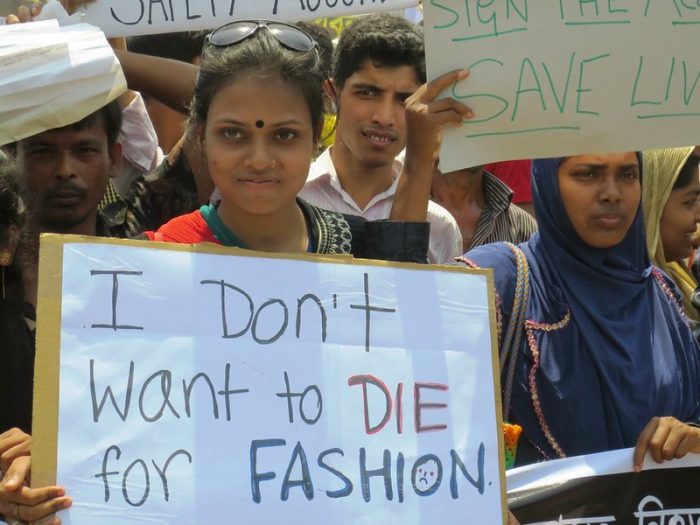Perhaps you’ve heard of the Rana Plaza collapse?
No shade if you haven’t and if that is the case, I am particularly glad that you’re here. In order to understand why the Bangladesh Accord is vitally important to the people it helps to protect, here is a brief overview of the history that got us here.
Sadly, it typically takes a tragedy for the world to sit up and take notice of the atrocities that are an everyday experience for many people on this planet.
But there has been progress in the garment industry—in the wake of the Rana Plaza collapse with the creation of the Bangladesh Accord. But that progress could become mute if the Accord is allowed to expire on August 31st, 2021.
Rana Plaza was an eight-story building located in Dhaka, Bangladesh. It housed five garment factories, many of which made clothing for some of the world’s most recognizable brands (including Zara, Walmart, Mango, Primark, United Colors of Benetton, The Children’s Place, and Joe Fresh). The April 2013 collapse killed 1,134 garment workers and left the survivors with deep emotional and physical scars causing many to be unable to return to work with no compensation or accountability for the injuries sustained.
Here’s the thing, Bangladesh is a massive apparel exporter to the U.S.—fourth behind China, Vietnam, and India (respectively).
To give that a little more context, even though the U.S. imports more apparel from China, it is only 8 percent of the country’s import share, compared to almost 90 percent of Bangladesh’s import share. Not to mention, on a global scale, Bangladesh is second only to China when it comes to apparel manufacturing. So, you can see why these factories and the uber cheap labor force they employ are vitally important to the nation’s economy.
Over 3.5 million workers, many of whom are women and children, are employed to keep up with the overwhelming demand of the Bangladeshi garment industry. To further the exploitation, these workers are subjected to physical and verbal harassment, poverty wages, retaliation for advocating for self or coworkers, and unsafe working conditions (including extreme heat and exorbitantly unsafe factories). Essentially some of the worst conditions in the industry.
Globalization and outsourcing has caused many brands to flock to Bangladesh. Why? Cheap labor of course!
The minimum wage for many factory workers is around 32 cents an hour. Which breaks out to about 68 dollars a month—far less than the country’s meager minimum wage of around 103 dollars per month. What’s worse is that the “ready-made” garment industry is worth over 30 billion dollars and it is logical to think that there should be enough revenue to pay workers a sustainable and livable wage.
“If something is very cheap, you have to ask yourself, is it really possible to make it in a factory that is run properly, with a living wage?” ~ Peter McAllister, the executive director of the Ethical Trading Initiative
So onto the Accord.
The Bangladesh Accord was a swift response to the Rana Plaza collapse.
In the days leading to the collapse, concerned workers reported deep cracks in the building and other clear signs of structural failure. But, just like so many other factory tragedies before it, factory owners forced these whistleblowers back to work. In essence, sentencing many to their deaths. While this sit down, shut up, and do your job or be fired rhetoric is commonplace in the garment production industry, this was not the first tragedy to highlight the, often inhumane, conditions garment workers face on a daily basis.
The collapse of Rana Plaza forced this painfully obvious system of oppression into the global stage, pleading to the rest of the world for recognition. And not only to acknowledge this disaster, but to make a lasting change. And quickly.
With their oversights splayed for the world to see, the notoriously unsafe Bangladesh garment industry, and the brands that chose to manufacture there, came under intense pressure from customers demanding change—lasting change that protected the workers who made their clothes.
There needed to be a way for brands to be held legally accountable. In a few short weeks, the Bangladesh Safety Accord was initiated.
Basically, The Accord is a legally binding agreement that was created by labor rights groups, Bangladeshi trade unions, and Global Union Federations. This agreement requires the disclosure of all supplier factories as well as independent building inspections, workers’ rights trainings, and the review of safety codes by all signatory brands and retailers.
To learn more about how this plays out in depth, click here.
So, What’s the Deal?
The Accord expires August 31, 2021. Thus, effectively limiting or ending progress, worker safety, and stakeholder accountability.
This first Accord was only valid for five years and ended in May 2018. From there, a new Transition Accord was enacted, but under arduous circumstances with the Bangladeshi government and the employers arguing that they no longer needed the Accord. A message of “look, we are all better now.” When this is clearly not the case. Many brands and retailers have come forward against the Accord in favor of limiting their operations in Bangladesh, or trusting the new national body formed in 2019 giving more power back to the government and stakeholders by limiting worker representatives to one third of the governance seats, instead of the one half that the Accord requires.
The reason that the Accord is so successful is that it is a binding legal agreement that has real ramifications if the brands, retailers, and factories don’t do enough to satisfy the specifications in the agreement.
“The Accord is very important for workplace safety. The Accord works independently and neutrally and has earned a good reputation and credibility, abroad and among workers. The Accord ensures the safety of the workplace for workers.” ~ Babul Akhter, Bangladesh Garment & Industrial Workers Federation (BGIWF), union signatory to the Accord.
Progress Under the Accord’s Independent Factory Inspections:
>> Over 144,000 fire, electrical, and structural hazards discovered in 1,600 Bangladeshi garment factories—with over 90 percent corrected.
>> Over 1.7 million workers trained on workplace safety.
>> Resolution of 359 worker safety and rights grievances.
The Accord Protects Workers’ Rights
A crucial feature of the Bangladesh Accord is giving garment workers a voice. The founders of the agreement built worker participation into every level. These are the individuals whose lives are on the line for the cost of a t-shirt, their voices matter most, the Accord has recognized that from its creation.
“Lots of brands had complaint mechanisms in factories before. Workers never trusted them” because nothing changed. The Accord’s complaint structure “created real, tangible prompt results. Factories were evacuated, workers were paid their compensation, their severance, whatever it might have been. It is seen as a trusted and reliable complaint mechanism that workers can use. And it is being used.” ~ Laura Guttierez of Workers Rights Consortium (WRC), one of the Accord’s witness signatories
Extension of Accord Commitments
Technically, the Accord was set to expire May 31, 2021, but there was an agreement to extend the Accord three months. This decision comes at the hands of global unions and international fashion brands to allow negotiations to continue.
Here’s the thing though, this provisionary agreement must still be signed by the individual brands that signed the original Accord. In effect renewing their promise to consumers. This is why the consumers’ voices, our voices must remain loud—and money talks!
What does that mean for other countries?
There has been real, tangible change in the Bangladeshi garment industry. But, if brands choose a national focus, they are actively denying worker representation along with any real accountability. This success and worker protection needs to continue! Brands need to be held accountable. The Accord has shown that change can happen and that the garment industry is capable of doing things differently.
The Accord is just the beginning. It is the cornerstone of progress for protecting the individuals who make our clothes. If the Accord isn’t upheld, this effectively takes away any chance of these types of protections in other countries. Thus sentencing millions of garment workers to continue to work in extremely unsafe environments with a high frequency of work-related accidents and deaths.
And yet, the industry is shrouded in secrecy. With each corporate loophole furthering the gap between the humans who make our clothes, the consumers—who are kept in the dark purposefully, and the CEOs and stakeholders (who seemingly couldn’t care less).
You see, because if you take the human element out of how our clothes are made, you largely limit the socioeconomic scope. Dehumanizing garment workers (who are largely immigrants—no matter the country) is the main reason why fast fashion brands can sell you a t-shirt for the price of a coffee. These are the ramifications that come from globalization. Now, this isn’t to say that globalization is inherently horrible. But it has allowed the western world to further the exploitation some of the most vulnerable with an alarming scope.
The Accord needs to continue.
~

 Share on bsky
Share on bsky







Read 10 comments and reply